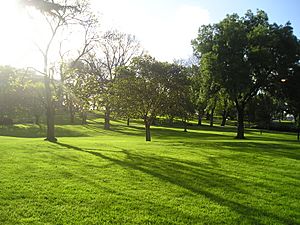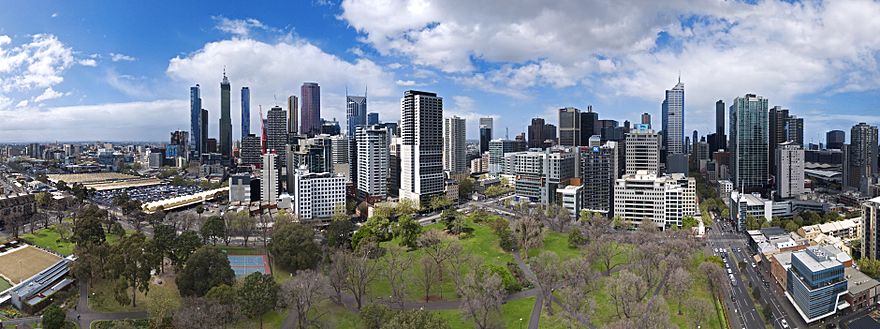Flagstaff Gardens facts for kids
Flagstaff Gardens is the oldest park in Melbourne, Victoria, Australia. It was first created in 1862. Today, many people visit and use this park, including locals, office workers, and tourists. The gardens are very important because of their history, the plants grown there, and what they mean to the community.
The gardens cover about 7.2 hectares (18 acres). They are located between William, La Trobe, King and Dudley streets. The City of Melbourne manages this park. Near the park, you can find the entrance to Flagstaff railway station. Across the street is the old Royal Mint building, which opened in 1869. This building shows off the fancy style of architecture from the Australian gold rush time. Also, the Queen Victoria Market is just across William Street from the park.
The park has large grassy areas with many different kinds of grown-up trees, colourful flowerbeds, and even wild animals like possums. The southern part of the park has trees that lose their leaves in autumn. The northern part has big eucalypt trees. There are also paths shaded by elm trees and large Moreton Bay Fig trees. In the north corner, you'll find a lawn for bowling, rose gardens, and other flower and shrub beds. Along William Street, there are tennis courts that can also be used for volleyball, handball, and netball. Nearby electric barbecues are popular for parties, especially in December. You'll also see memorials and sculptures around the park that tell stories about the area's social history.
Flagstaff Gardens is officially recognised as an important place by the National Trust of Australia (Victoria) and is listed on the Australian Heritage Commission and the Victorian Heritage Register. In 2004, when it was added to the Victorian Heritage Register, the Council Chair, Chris Gallagher, said that this listing helps protect the beloved trees, landscaping, and other features. It also means the whole site is seen as a key place to learn about Melbourne's history, archaeology, beauty, plants, and social life.
History of Flagstaff Gardens
When Melbourne was first settled in 1835, the first people who died in the new colony were buried on a high piece of land between William and King Streets. People called this place Burial Hill. From this hill, you could see great views of the small town, the Yarra River, and Port Phillip.
- 1838: A new cemetery was marked out where the Queen Victoria Market is now. Burials then moved to this new spot.
- 1839: Superintendent Charles La Trobe included this site as part of a green belt of parks around Melbourne. Other parks in this belt included Carlton Gardens, Fitzroy Gardens, Treasury Gardens, and the Kings Domain.
- 1840: A tall pole, called a flagstaff, was put up on the hill. It was used to send signals between the town and ships in the Port of Melbourne. The first flagstaff was too small, so a bigger one (15 metres tall) was put up the next year.
- 1850: On November 11, it was announced here that Victoria would become a separate colony from New South Wales. About 5,000 townspeople celebrated with a huge bonfire!
- 1857: A cut was made to make King Street less steep. This created the bluestone wall you can see along the western side of the park.
- 1857–1863: A special building for studying magnetism and a weather station were set up on the hilltop by Georg von Neumayer. William John Wills, who later became famous for the Burke and Wills expedition, worked here. The observatory later moved because iron in nearby buildings was affecting the magnetic readings.
- 1860s: The electrical telegraph became popular, and people stopped using flags to send signals.
- 1862: People living in West Melbourne asked the government to turn the hill into public gardens. Clement Hodgkinson, who was in charge of city parks, made a plan for the gardens and helped make it happen. He also designed the Fitzroy Gardens and Treasury Gardens.
- 1871: A memorial was put up to remember Melbourne's early settlers.
- 1873: The gardens were officially set aside forever as a public park.
- 1880: Paths, lawns, trees, and flowerbeds were fully established.
- 1917: On October 9, the City of Melbourne became responsible for looking after Flagstaff Gardens.
- 1918: One of Melbourne's first playgrounds for children was built here.
- 2004: On March 23, the gardens were officially added to the Victorian Heritage Register.



